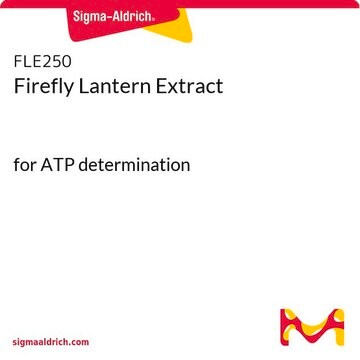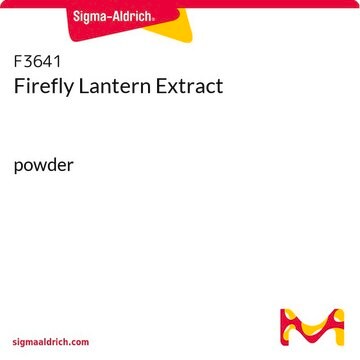L9420
Luciferase from Photinus pyralis (firefly)
recombinant, expressed in E. coli, buffered aqueous solution, ≥10×1010 units/mg protein
Synonim(y):
Luciferase firefly
About This Item
Polecane produkty
rekombinowane
expressed in E. coli
Poziom jakości
Próba
≥98% (SDS-PAGE)
Postać
buffered aqueous solution
aktywność właściwa
≥10×1010 units/mg protein
masa cząsteczkowa
62 kDa
Warunki transportu
dry ice
temp. przechowywania
−20°C
Szukasz podobnych produktów? Odwiedź Przewodnik dotyczący porównywania produktów
Powiązane kategorie
Opis ogólny
Zastosowanie
Definicja jednostki
Unit Definition Conversion Factor: There are approximately 9000 Relative Light Units (RLU) per one traditional Light Unit that uses a peak height equivalent to 0.02 μCi of 14C in a PPO/POPOP cocktail.
Postać fizyczna
Hasło ostrzegawcze
Danger
Zwroty wskazujące rodzaj zagrożenia
Zwroty wskazujące środki ostrożności
Klasyfikacja zagrożeń
Acute Tox. 4 Oral - Resp. Sens. 1 - STOT RE 2 Oral
Organy docelowe
Kidney
Kod klasy składowania
10 - Combustible liquids
Klasa zagrożenia wodnego (WGK)
WGK 3
Temperatura zapłonu (°F)
231.8 °F
Temperatura zapłonu (°C)
111 °C
Certyfikaty analizy (CoA)
Poszukaj Certyfikaty analizy (CoA), wpisując numer partii/serii produktów. Numery serii i partii można znaleźć na etykiecie produktu po słowach „seria” lub „partia”.
Masz już ten produkt?
Dokumenty związane z niedawno zakupionymi produktami zostały zamieszczone w Bibliotece dokumentów.
Klienci oglądali również te produkty
Produkty
Bioluminescence imaging (BLI) systems allows for high-sensitive and noninvasive monitoring of cell proliferation, activity of signaling pathways and protein-protein interactions in living tissues.
seMpai substrate is suitable for near-infrared BLI in biological experiments, offering high solubility for extended bioluminescent applications.
Firefly luciferase is a sensitive reporter for gene studies due to its absence in mammalian cells or tissues.
Lucyferaza Firefly jest czułym reporterem do badań genów ze względu na jej brak w komórkach lub tkankach ssaków.
Nasz zespół naukowców ma doświadczenie we wszystkich obszarach badań, w tym w naukach przyrodniczych, materiałoznawstwie, syntezie chemicznej, chromatografii, analityce i wielu innych dziedzinach.
Skontaktuj się z zespołem ds. pomocy technicznej













